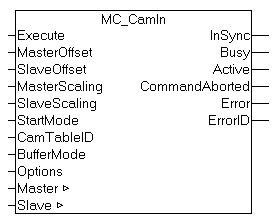MC_CamIn

The function block MC_CamIn activates master-slave coupling with a certain cam plate. In addition it is possible to switch to a new cam plate in coupled state. The switching rules, in particular the time or position, can be specified.
The status flag Axis.Status.CamTableQueued can be used to check whether a cam plate is queued for switchover.
Important:
Further information on coupling with cam plates
ActivationMode (coupling or switching of cam plates)
Inputs
VAR_INPUT
Execute : BOOL;
MasterOffset : LREAL;
SlaveOffset : LREAL;
MasterScaling : LREAL := 1.0;
SlaveScaling : LREAL := 1.0;
StartMode : MC_StartMode;
CamTableID : MC_CAM_ID;
BufferMode : MC_BufferMode;
Options : ST_CamInOptions;
END_VAR Execute | The command is executed with a rising edge at input Execute | |
MasterOffset | Offset to the master position of the cam plate | |
SlaveOffset | Offset to the slave position of the cam plate | |
MasterScaling | Scaling of the master position of the cam plate | |
SlaveScaling | Scaling of the slaveposition of the cam plate | |
StartMode | StartMode determines whether the cam plate position is interpreted absolute or relative to the coupling position. | |
CamTableID | ID of the cam plate used for coupling | |
BufferMode | currently not implemented | |
Options
| Data structure with further coupling and switching options: | |
ActivationMode | ActivationMode specifies the switching time or position at which cam plate coupling or switchover takes place. | |
ActivationPosition | Optional master position at which a cam plate is switched, depending on the ActivationMode. | |
MasterScalingMode : | Optional Scaling mode for the master position of the cam plate | |
SlaveScalingMode | Optional Scaling mode for the Slave position of the cam plate | |
InterpolationType | Interpolation type for position tables. Not required for motion functions. | |
Outputs
VAR_OUTPUT
InSync : BOOL;
Busy : BOOL;
Active : BOOL;
CommandAborted : BOOL;
Error : BOOL;
ErrorID : UDINT;
END_VARInSync | Becomes TRUE, if the coupling was successful and the cam plate is active. |
Busy | The Busy output becomes TRUE when the command is started with Execute and remains TRUE as long as the command is processed. When Busy becomes FALSE again, the function block is ready for a new command. At the same time one of the outputs, InSync, CommandAborted or Error, is set. |
Active | Active indicates that the command is executed. For cam plate switching Active becomes TRUE, if the coupling command was executed successfully but the cam plate is still queued. If the cam plate is activated depending on the ActivationMode, Active becomes FALSE and InSync is set. |
CommandAborted | Becomes TRUE, if the command could not be fully executed. The axis may have become decoupled during the coupling process (simultaneous command execution). |
Error | Becomes TRUE, as soon as an error occurs. |
ErrorID | If the error output is set, this parameter supplies the error number. |
Inputs/outputs
VAR_IN_OUT
Master : AXIS_REF;
Slave : AXIS_REF;
END_VARMaster | Master axis data structure. |
Slave | Slave axis data structure. |
The axis data structure of type AXIS_REF addresses an axis uniquely within the system. Among other parameters it contains the current axis status, including position, velocity or error status.